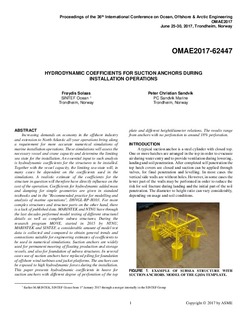| dc.contributor.author | Solaas, Frøydis | |
| dc.contributor.author | Sandvik, Peter Christian | |
| dc.date.accessioned | 2017-11-29T07:36:30Z | |
| dc.date.available | 2017-11-29T07:36:30Z | |
| dc.date.created | 2017-11-28T08:33:38Z | |
| dc.date.issued | 2017-06-25 | |
| dc.identifier.citation | ASME 2017 36th International Conference on Ocean, Offshore and Arctic Engineering - Volume 9: Offshore Geotechnics; Torgeir Moan Honoring Symposium | nb_NO |
| dc.identifier.isbn | 978-0-7918-5777-9 | |
| dc.identifier.uri | http://hdl.handle.net/11250/2468315 | |
| dc.description.abstract | Increasing demands on economy in the offshore industry and extension to North Atlantic all-year operations bring along a requirement for more accurate numerical simulations of marine installation operations. These simulations will assess the necessary vessel and crane capacity and determine the limiting sea state for the installation. An essential input to such analysis is hydrodynamic coefficients for the structures to be installed. Together with the vessel capacity, the limiting sea-state will, in many cases be dependent on the coefficients used in the simulations. A realistic estimate of the coefficients for the structure in question will therefore have directly influence on the cost of the operation. Coefficients for hydrodynamic added mass and damping for simple geometries are given in standard textbooks and in the “Recommended practice for modelling and analysis of marine operations”, DNVGL-RP-H103. For more complex structures and structure parts on the other hand, there is a lack of published data. MARINTEK and NTNU have through the last decades performed model testing of different structural details as well as complete subsea structures. During the research program MOVE, started in 2015 by NTNU, MARINTEK and SINTEF, a considerable amount of model test data is collected and compared to obtain general trends and connections suitable for engineering estimates of coefficients to be used in numerical simulations. Suction anchors are widely used for permanent mooring of floating production and storage vessels, and also for foundation of subsea structures. In several cases use of suction anchors have replaced piling for foundation of offshore wind turbines and jacket platforms. The anchors can be exposed to high hydrodynamic forces during the installation. This paper presents hydrodynamic coefficients in heave for suction anchors with different degree of perforation of the top plate and different height/diameter relations. The results range from anchors with no perforation to around 18% perforation. | nb_NO |
| dc.language.iso | eng | nb_NO |
| dc.publisher | ASME Digital collection | nb_NO |
| dc.relation.ispartof | ASME 2017 36th International Conference on Ocean, Offshore and Arctic Engineering - Volume 9: Offshore Geotechnics; Torgeir Moan Honoring Symposium | |
| dc.relation.ispartofseries | ASME Proceedings | Torgeir Moan Honoring Symposium;OMAE2017-62447 | |
| dc.rights | Navngivelse-Ikkekommersiell-DelPåSammeVilkår 4.0 Internasjonal | * |
| dc.rights.uri | http://creativecommons.org/licenses/by-nc-sa/4.0/deed.no | * |
| dc.subject | Suction | nb_NO |
| dc.title | Hydrodynamic Coefficients for Suction Anchors during Installation Operations | nb_NO |
| dc.type | Chapter | nb_NO |
| dc.description.version | acceptedVersion | nb_NO |
| dc.rights.holder | The authors | nb_NO |
| dc.identifier.doi | 10.1115/OMAE2017-62447 | |
| dc.identifier.cristin | 1519267 | |
| dc.relation.project | Norges forskningsråd: 237929 | nb_NO |
| cristin.unitcode | 7566,8,0,0 | |
| cristin.unitname | Ocean Engineering | |
| cristin.ispublished | true | |
| cristin.fulltext | postprint | |
| cristin.qualitycode | 1 | |

